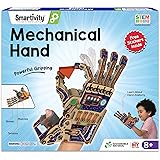Unleashing Creativity: Essential Smart Gadgets for Your Next DIY Electronics Project
In a world increasingly driven by technological innovation, the realm of DIY electronics projects has exploded, making advanced capabilities accessible to hobbyists and makers alike. Did you know that the global market for DIY electronics is projected to grow significantly, reflecting a burgeoning interest in personal creation and smart home solutions?
The video above provides a fantastic visual tour of several key electronic modules that can transform your project ideas into tangible realities. While the video showcases these components in action, this comprehensive guide will delve deeper into each gadget, offering extended insights, potential applications, and practical considerations for integrating them into your very own smart DIY projects.
Building your own smart gadgets for DIY doesn’t have to be complicated. Instead, it becomes an exciting journey when you understand the foundational components. Let’s explore the essential modules that empower countless innovative creations.
The Cornerstone of Power: Breadboard Power Supply Modules
Every electronic project requires a stable and reliable power source. The breadboard power supply module, often considered one of the most used boards for experimenting with Arduino, serves precisely this purpose. It efficiently steps down higher voltages, typically from a wall adapter, to the precise levels your delicate components need.
These mini power supplies offer dual voltage outputs, commonly providing both 3.3 volts and 5 volts DC. This versatility is crucial because different microcontrollers and sensors operate at distinct voltage requirements. For instance, while most Arduino boards prefer 5V, many modern sensors and communication modules operate optimally at 3.3V.
Imagine if you could quickly switch between these voltages with a simple jumper cap—that’s exactly what these modules allow. Onboard, you’ll find two independent sets of output pins, giving you flexibility for projects requiring mixed voltage levels. Remarkably, you can acquire these incredibly useful modules from online stores for a modest price, often ranging from just $2 to $3, making them an indispensable and budget-friendly part of your DIY toolkit.
Illuminating Your Ideas: Diverse Display Modules for DIY Electronics
Displays provide the vital visual feedback that transforms a circuit board into an interactive gadget. The video highlights a few popular options, each with unique strengths.
The Workhorse: 16×2 LCD Display
The 16×2 LCD display, capable of showing 16 characters across two lines, remains a staple in DIY electronics projects. Its simplicity and robust nature make it perfect for displaying sensor readings, status messages, or short instructions. As demonstrated in the video, pairing it with an Arduino board, a soil moisture sensor, a relay, and a water pump instantly creates an automatic plant watering system. This basic text display is invaluable for countless applications, from simple timers to basic user interfaces, providing clear information without complex graphics.
Graphic Capabilities: Nokia 5110 LCD Display
When your project demands more than just text, the 84×48 pixel Nokia 5110 LCD module steps in. Operating within a voltage range of 2.7 to 3.3 volts and drawing a mere 50 milliamps, this 1.5-inch screen offers graphic capabilities in a compact form factor. Its monochrome display is perfect for plotting simple graphs, creating custom icons, or even displaying low-resolution images. Historically popular from its use in mobile phones, this module gives your smart gadgets a retro yet highly functional visual edge, ideal for weather stations, simple games, or custom menu systems.
Dynamic Visuals: LED Dot Matrix Displays
For striking visual effects and dynamic animations, the LED dot matrix display is an excellent choice. The video showcases an 8×8 LED matrix, totaling 64 individual LEDs, used to create an impressive LED hourglass for chess. This particular module is a favorite among makers due to its ability to display scrolling text, custom animations, or even simple pixel art. By combining two such displays with a tilt switch and an Arduino Nano board, you can create interactive gadgets that respond to physical movement, producing truly captivating visual feedback.
Sensing the Environment: Smart Sensors for Intelligent Projects
Smart gadgets gain their “intelligence” from sensors that perceive the physical world. The transcript highlights a variety of sensors critical for environmental monitoring and safety.
Nurturing Nature: Soil Moisture Sensors
For plant enthusiasts, a soil moisture sensor is a game-changer. These sensors detect the water content in soil, sending a signal to your microcontroller. In conjunction with an LCD display and a water pump activated by a relay, you can build an automatic watering system for plants. This not only ensures your plants receive optimal hydration but also conserves water by only watering when necessary, making your smart garden efficient and self-sufficient.
Temperature and Humidity Tracking: The DHT11 Sensor
Monitoring environmental conditions like temperature and humidity is fundamental for many smart home applications. The DHT11 sensor is a popular and cost-effective module that accurately measures both. You can integrate this with an Arduino and a display to create a digital thermometer and hygrometer. Imagine if you could precisely track the conditions in a greenhouse or a baby’s room, making adjustments as needed. For more precise or robust applications, upgraded versions like the DHT22 offer even greater accuracy.
Ensuring Safety: MQ-Series Gas Sensors
Safety is paramount, and gas sensors play a critical role in detecting hazardous conditions. The video introduces two important MQ-series sensors:
- MQ9 Carbon Monoxide and Flammable Gas Sensor: This sensor detects the concentration of both carbon monoxide (CO) and combustible gases (like methane or propane) in the air. Crucially, it outputs its reading as an analog signal, allowing your Arduino to precisely interpret the gas levels. Deploying this in your smart home can provide an early warning system for potential gas leaks or dangerous CO buildup, a silent killer often undetectable by human senses.
- MQ3 Alcohol Gas Sensor: Primarily useful for detecting alcohol vapor, the MQ3 sensor finds applications beyond typical gas leakage detection. While it can identify alcohol in industrial settings, it’s also a common component in DIY breathalyzers or systems designed to monitor alcohol presence in specific environments, adding another layer of specialized sensing to your smart gadgets.
When working with gas sensors, it’s essential to consider calibration and potential cross-sensitivity to ensure accurate and reliable detection.
Interactive Creations: Input and Output Modules
Bringing your smart gadgets to life means enabling them to interact with the world and respond to user input.
Controlling Power: The Relay Module
Relays act as electronic switches, allowing low-power microcontrollers like Arduino to control high-power electrical appliances, such as water pumps, lights, or motors. The relay for activating a water pump, as seen in the automatic watering system, exemplifies its use. Instead of directly subjecting your microcontroller to high voltages, the relay safely isolates the circuits, protecting your sensitive electronics while enabling powerful actions.
Recording and Playing Audio: The Recordable Module
For adding an auditory dimension to your projects, a recordable module is invaluable. This compact gadget features a microphone and three push switches: record, play once, and play all. Operating on 5 volts, it can record and playback short audio messages through a small speaker. Imagine if you could create custom sound effects for a talking toy, a smart doorbell with personalized greetings, or an interactive display that offers audio instructions. This module, available for around $4 with a speaker, provides an accessible way to integrate voice and sound into your DIY creations.
From Concept to Creation: The Importance of Custom PCBs
While breadboards are excellent for prototyping, finished smart gadgets often require robust and permanent circuit boards. This is where custom Printed Circuit Boards (PCBs) come into play.
As highlighted in the video with the stunning quality of the presented PCB, manufacturing custom boards gives your projects a professional finish and significantly improves reliability. Designing your own PCB ensures all components are securely mounted and connections are stable, moving beyond the temporary nature of breadboard setups.
Companies like PCBWay, the sponsor of the video, provide accessible and high-quality manufacturing services for custom PCBs. Their offerings make it easier for DIY enthusiasts to transition from a prototype to a polished product. Notably, new customers often benefit from offers like a free first PCB prototype board, an incredible opportunity to bring your unique designs to life without initial cost barriers.
Embark on Your Next DIY Electronics Adventure
The array of smart gadgets and electronic modules available today empowers you to create almost anything you can imagine. From simple power supplies and versatile displays to intelligent sensors and interactive audio modules, each component unlocks new possibilities for your DIY electronics projects.
By understanding how these elements work individually and in combination, you gain the ability to build sophisticated, custom solutions that cater to your specific needs. Dive into the world of smart gadgets for DIY projects, experiment with these modules, and let your creativity lead the way. Remember, the journey from an idea to a functional gadget is both rewarding and educational, providing invaluable experience in the exciting field of DIY electronics.







